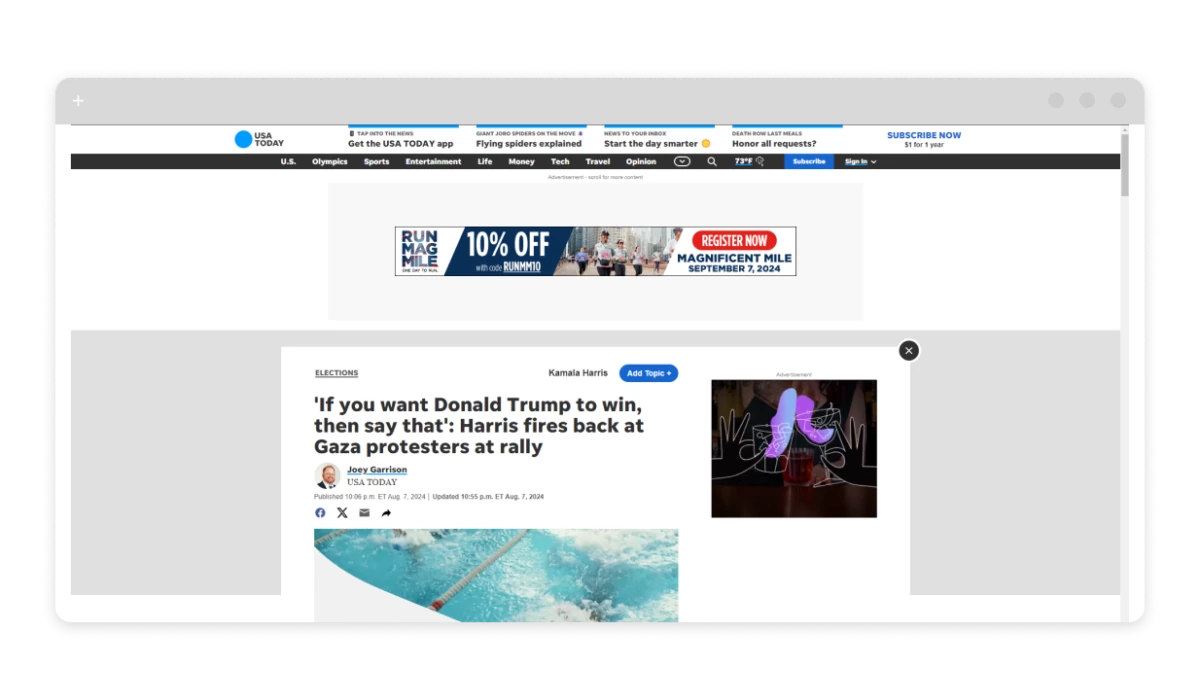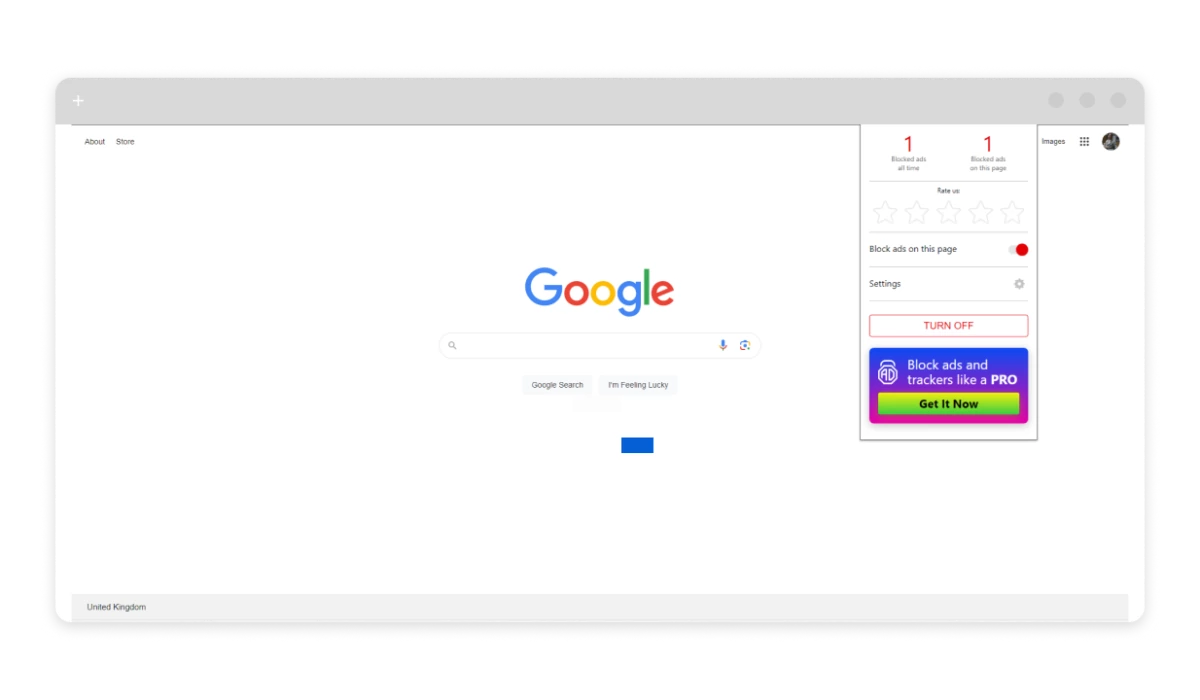How to Get Rid of Ads on USA Today in a Snap
Reading the news, whether it is on USA Today or the Forbes website, has become a part of our daily routine. No matter the topic, we all browse updates on current situations — sports, politics, economics, stock market, you name it. We want to stay in touch with the fast-paced life and world activity. Sometimes reading the news can be very irritating because of the commercials popping up here and there and disrupting the flow. Given that peppering the websites with ads is the main source of income for the news providers, they won’t go away.
So if you are looking for a working solution that would help you in blocking USA Today ads and provide a smoother browsing experience, you’ve come to the right place. We’ll guide you through the trusted and working methods for blocking ads. Buckle up!
Types of ads on USA Today
There is nothing special there, the average and common set of ads:
- Display ads that include banners, squares, and rectangles appearing on the sides and around the content blocks;
- Native ads — these blend with the surrounding content as if they were a part of it. They are designed to be less intrusive and more engaging to the reader;
- Video ads including pre-mid-post rolls and iframes;
- Sponsored and affiliate content dedicated to specific advertisers or brands partnered with the newspaper;
- Pop-ups and pop-unders — the most annoying type of digital ad that appears on the screen in the most inconvenient moment of interaction with the content. These can take up to 60% of the screen and have a tiny “x” button that you won’t hit with your first tap.



And although commercials on news websites are not the worst out of all, the barrage they sometimes do causes cognitive overload. Irritated and overwhelmed users tend to leave the website because of that and they never come back.
Luckily, there are multiple ways to get rid of ads on USA Today and on the Internet in general and we’ll tell you how to do it.
Use the USA Today Ad Blocker
Of course, the easiest and most logical way of removing ads from any website is to install an adblocker. It’s worth mentioning that not all adblocking solutions are equally efficient as the way ads are being served is constantly changing and altering. Some of the free adblockers are rarely updated to meet the changes and hence fail to block the refreshed way of ad delivery. You should choose the software that is timely updated and supported, for instance, AdLock. Blocking ads scattered across the Internet using AdLock is pretty straightforward and does not require hassling around. So here’s how you can enjoy ad free USA Today with AdLock:
On PC
- Download and Install AdLock:
- Visit the AdLock website and download the installer for your operating system (Windows or macOS);
- Run the installer and follow the instructions to complete the installation and setup;
- Configure AdLock:
- Open the AdLock application;
- Go to the settings;
- Check for the latest filters and core updates by pressing the corresponding button.
- Activate Ad Blocking:
- Navigate to “Ad Blocking”;
- Ensure that the main toggle is switched ON;
- AdLock should automatically start blocking ads on all websites, including USA Today.
On Mobile (Android):
- Download and Install AdLock:
- Visit the AdLock website and download the AdLock APK file since it’s unavailable on the Google Play Store;
- Launch the APK installer and follow the instructions on your screen. You may need to allow installations from unknown sources in your device’s settings.
- Configure AdLock:
- Open the AdLock app.
- Go through the initial setup process.
- Ensure that AdLock is enabled and that it starts automatically.
- Enable HTTPS Filtering:
- To block ads on websites that use HTTPS, you need to enable HTTPS filtering;
- You will need to install the HTTPS certificate that is uniquely generated for your device and exists only in 1 copy on your device;
- Go to the settings in the AdLock app and find the HTTPS filtering option.
- Follow the instructions to install the AdLock certificate.
- Block Ads:
- AdLock will automatically start blocking ads across apps and browsers, including the one you use to access USA Today.
On iOS:
AdLock for iOS is available in the App Store. To install it on your device:
- Run the App Store application;
- Tap the “Search” icon at the bottom of the screen;
- Type “AdLock” in the search field, and then tap the search result;
- Tap the “GET” button under the “AdLock: Ads & Adware removal”;
- Press the “Install” button;
- Type your Apple ID login and password in the dialogue window, and wait for the installation to complete;
- Follow the on-screen instructions to set up AdLock, and you’re good to go.
If you encounter any problems on your way to setting up proper adblocking, you can read the user guide here or contact our customer support.
How to Block Ads on the USA Today Website
Another way of blocking ads on USA Today (specifically on the website if you don’t need the systemwide adblocking on all browsers and apps) is by using an adblocking extension. In the majority of cases, extensions perform quite well and remove the lion’s share of all those disruptive commercials messing up the content and making your reading experience unpleasant.
There are quite a few good adblocking extensions out there. For instance, uBlock Origin, AdLock, and Ghostery – just to name some.
The best thing about these is that they are completely free of charge and have no hidden fees. Installing one of the extensions is quite easy and it goes like this (let’s consider you use Chrome or Edge as the browser of your choice):
For Chrome:
- Install AdLock Extension:
- Open the Chrome Web Store;
- Search for “AdLock”;
- Click “Add to Chrome”;
- Pin it to the extensions bar for easy access and control.
- Enable Ad Blocking:
- After installation, click on the AdLock icon in the toolbar.
- Make sure that the ad blocker is turned on. You can customize the settings if needed, but by default, AdLock will block USA Today ads on Chrome right away.
For Edge:
- Install AdLock Extension:
- Go to the Microsoft Edge Add-ons store;
- Search for “AdLock”;
- Click on “Get” and install the extension.
- Enable Ad Blocking:
- Click on the AdLock icon in the Edge toolbar;
- Ensure that ad blocking is activated to block ads on the USA Today website.


Installing uBlock Origin on your browser is the same, so you will have no issues with that. But please, make sure you only have one adblocking extension enabled on your browser as if there’s more, then they will interfere with each other. This means that none of them will be working properly.
Remove Ads From the USA Today App on Android
The faultless and reliable way to remove ads from the USA Today app on Android is to install a full-fledged standalone adblocker app like AdLock. Its network-level operation allows blocking all ad requests and redirects which means commercials are getting removed before they even reach your device. Such an adblocker will also remove ads from all apps, games, and browsers on your device.
Another efficient method is to use a private DNS service that blocks ads at the network level. By configuring your Android device to use a private DNS provider, you can prevent ads from appearing in the app without needing any additional software. This DNS-level blocking is seamless and doesn’t require constant updates or adjustments once set up.
And last but not least, you can try using a VPN with built-in adblocking features. It won’t be as effective as an actual usatoday adblocker for Android, but will definitely help you reduce the number of ads on your screen.
Remove Ads From the USA Today App on iOS
Due to how peculiar the iOS ecosystem is, regular adblockers fail to perform well on iPhones. You will have to search for an app that has content blocker features. By downloading a trusted content blocker from the App Store, such as AdLock or 1Blocker, you can integrate it with Safari and reduce ads across various apps that use web views, including USA Today.
Another approach is to set up a private DNS on your iOS device. By configuring your network settings, you can block ads at the network level, which prevents them from loading within the app. This method is hassle-free and requires no additional adjustments.
Using a VPN with built-in ad-blocking capabilities can also be highly effective. Many VPN services offer ad-blocking as part of their feature set, which can filter out ads while also providing the added security of encrypted browsing.
How to Stop USA Today Pop-ups
For users accessing USA Today via a web browser on a mobile device or desktop, the most effective way to block popups is by using a dedicated ad blocker like AdLock or uBlock Origin. These extensions work by filtering out popup scripts and preventing them from loading in the first place.
On Android, using an ad-blocking app like AdLock can effectively stop popups within the USA Today app itself.
For iOS users accessing USA Today through Safari, enabling a content blocker in Safari’s settings can help manage popups.
You can also adjust the built-in pop-up blocking features on browsers like Safari, Firefox, Opera both on mobile and desktop. This feature helps manage and block annoying popups across different websites and platforms. It won’t block everything, of course, because the way ads are delivered constantly change, but it will reduce the overall number of ads on your screen.
Final Thoughts
These are the most efficient and 100% working solutions to the ad barrage on the Internet and USA Today in particular. By employing one of these methods — or combining them — you can significantly improve your web surfing experience, eliminating distracting ads and trackers. Download AdLock and enjoy USA Today without ads no matter the OS, we’ve got everything covered.